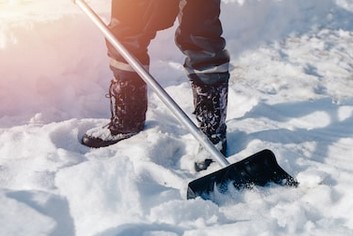Muddy snow and mirror-smooth surfaces on roads and paths endanger motorists and pedestrians alike in winter. To clear your property of ice and snow, you can choose between two basic methods: either with muscle power or with motorised equipment.
This depends on the amount of snow and the size of the area to be cleared. For example, a snow shovel or snow tub is usually sufficient, but if you live in an area with a lot of snow and have to cover a large area, it is worth purchasing a snow blower.
Clearing snow is a must

But no matter which clearing device you use: If you are the owner of a property, you must take precautions to ensure that your property does not pose a danger to others. This means that you are obligated to winter road clearance in the event of snowfall and icy conditions: You must clear snow from the entrances to your house and, in most cases, from the sidewalks leading past your property. The sidewalk must remain passable over a width of 1.50 m. The sidewalks must be accessible over a width of 1.50 m. Most municipalities have laid down this regulation for winter road clearance (in this or a similar way) in their municipal regulations or the street cleaning statutes. It is worth taking a look at the legal text of your place of residence if you want to carry out winter road clearance services carefully. In the event of accidents, you will otherwise quickly find yourself partly to blame.
Snow clearing: 5 tips on how to make things easier
In order to make the work of clearing snow easier, you should follow the tips in our instructions. The correct posture is essential when snow shovelling. In order to prevent back pain or even injuries, you should observe the following points when working on the snow shovel:
- Loose snow can be pushed away without pressure with a snow shovel. Always work diagonally to the joint if the sidewalk slabs are offset too much!
- The handle end of the snow shovel should be at hip height.
- Place your hands at a distance – the leverage effect can be used optimally and you save power when clearing snow.
- Take a lunge step and go to your knees easily. The movement of the shovel must come out of the legs.
- If you shovel the snow away to the side, you should not only turn your upper body, but your whole body. Always make sure you have a straight back.
Dull materials such as sand, chippings and granules have proven to be effective as scattering material. Salt, on the other hand, attacks the brickwork and disturbs the water balance of the plants – in many communities the use is therefore prohibited.
Snow clearing in the garden
Also for garden owners there is a lot to do in case of snowfall. Few snowflakes a day that only “sugar” the soil gently are no problem. Usually the powder snow thaws during the day and seeps into the ground. If the consistency of the snow is light and powdery, it may remain in the garden. If, for example, it is or becomes wet and heavy due to thaw, this can have a negative effect: Bamboo and evergreen shrubs such as boxwood and cherry laurel can break apart under the weight. Endangered are above all evergreen plants (because the snow finds more hold there) and grafted plants (roses, fruit trees, …). Therefore one should sweep the snow with shovel or broom from the plant or shake carefully from the branches.
When you step on the lawn, the snow thickens, which leads to an air seal. The possible typhula rot, also known as snow mould, has a negative effect on the next garden season. The reasons for the infestation are the relatively constant temperatures and the high humidity under the solid snow cover. Even without snow you should not enter the lawn during permafrost – the stalks bend and the lawn is weakened.
The question remains: Where to put all the snow after clearing the sidewalks? Do not create them at the edge of the sidewalk from the property to the street, however, on beds or green areas. This is because road salt (if allowed in your municipality) can cause damage to the lawn as soon as the snow thaws. Snow from garden paths simply piles up along the wayside – in thaw, precipitation seeps into the ground. However, do not pile up snow on beds or lawns!